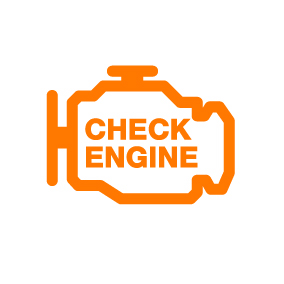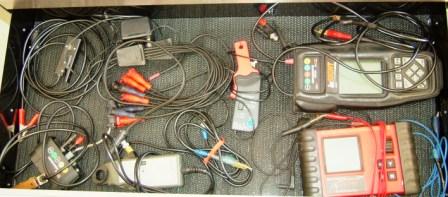This article was written in 1994. It’s even more fitting today.
Modern Automobile Diagnostics

It has always required skill to quickly and easily diagnose a car’s engine performance problems. (Today we call them “driveability” problems.) Back in the old days, even if you didn’t possess that much skill, and guessed wrong about a problem, you wouldn’t have too many parts to replace before it started running right!
But the computerized fuel and ignition systems of the eighties and nineties take more than a passing knowledge of auto mechanics to pinpoint their problems. Without the proper knowledge and equipment a person could spend several hundred dollars guessing, and still not come close to fixing the problem.
Why all the gadgetry?
The main reason is to control emissions, thereby making our planet a happier, healthier place to live. ___
A properly functioning electronic fuel injection system can much more accurately feed the right amount of fuel to the engine than a carburetor. This more accurate delivery of fuel, and control of ignition timing and emission control components also produces better gas mileage and performance.
Computers
All modern cars and trucks use small computers to fine tune the engine as you drive. (Some common acronyms for the computer are PCM, ECM, ECA and ECU.) The “onboard” computer receives signals from various sensors on the engine and chassis. These sensors provide information the computer needs to adjust various engine functions to meet the demands of any driving condition.
Making sense of Sensors
Here are just some of the sensors and an idea of what they do…
- VSS (Vehicle Speed Sensor) tells the computer how fast the car’s going.
- TPS (Throttle Position Sensor) tells how far down your foot is on the gas pedal.
- MAP Sensor (Manifold Air Pressure) tells how much of a “load” the engine is under by measuring intake manifold “vacuum”.
- Oxygen Sensor tells the computer if it needs to make further adjustments to the fuel mixture by measuring oxygen(O2) in the exhaust stream.
- Crankshaft or Camshaft position sensor tells the computer where these shafts are as they spin around thousands of times a minute.
- CTS (Coolant Temperature Sensor) tells the computer whether your engine is hot, cold or somewhere in between.
Trouble Codes
Most cars have a self-diagnostic system that can give very valuable information about problems the computer system may be having. Sometimes the car’s computer can sense a problem, and it stores a “trouble code” in its memory.
These codes don’t tell you exactly which component is bad, but they do give you a place to start looking that can lead to the source of the problem.
Many driveability problems don’t store a code, and it must be found through analyzing data given from the sensors and computer.
What the computer controls…
Today’s computers usually control at least the following engine functions:
- Fuel Mixture (The ratio of gas to air, it takes just the right amount of each to burn efficiently.)- The computer controls how long the fuel injector(s) stays open, thereby regulating how much gas the engine gets.
- Idle Speed- the computer tells your engine how fast to run while sitting at a stop light.
- Ignition Timing- used to be controlled mechanically (by vacuum and centrifugal advances), now the main computer tells the ignition module (another little computer) when to fire the spark plugs.
- Many cars now don’t even have a distributor, the computer tells individual coils when to fire for each cylinder!
- How much EGR (Exhaust Gas Recirculation) the engine receives
- Fuel evaporation canister purging- the computer tells your engine when to suck up extra fumes from the gas tank, so they won’t go out in the atmosphere.
- These are just a few of the sensors and functions of the car’s computer.
- The little hesitation you feel could be caused by a malfunction in any one or combination of them.
- Aren’t you glad you don’t have to figure out which one!

And if that’s not enough!
Anti-lock Brakes Air bag systems
Ride Control Climate Control
Trip computers Electronic dashes
These systems usually have additional computers with their own accompanying sensors and actuators! Diagnosing them requires still more equipment and manuals.
Buying a “Computer Diagnosis”
If you are having a driveability problem, beware of certain types of “computer checks”.
For $85 to $100, some places offer to hook your car up to “the machine”, sometimes a twenty or thirty thousand dollar machine that does a “Computer test”, it gives you a print out about two feet long describing your car’s condition. Very often many of the tests it runs are not related to your particular problem, and will not help to solve it.
(2009 NOTE- these single machines are not in widespread use today , though the principle is the same, you have to have a qualified tech interpret the data from your test equipment.)
Whether it’s a shop’s engine analyzer, or the car’s onboard computer (accessed with a “scan tool”), no machine has the ability to zero in on your specific problem like a trained technician.
These large machines that give the famous “print out” look impressive, but often they don’t find the problem you brought your car there to fix. They do generate a lot of business for the repair shop, because it can usually find something wrong with your car.
You’re better off having a qualified technician test systems that are related to your particular problem.
There are indeed many tools and instruments needed to diagnose today’s driveability problems, but a skilled technician is still needed (now more than ever) to know which instrument to use, and how to interpret the data it provides.
Bat-Tech verses “The Riddler”
Sometimes “computer” problems are fairly easy to solve. Unfortunately, some problems are not so easy. Even with the proper knowledge, equipment and reference manuals, finding the answer to the riddle can involve hours of measuring voltage outputs and inputs and tracing flow charts and wiring diagrams.
You Can Help Bat-Tech Win His Battle Against Grime!
Before you take your car in, print and fill out the Diagnostic Communication Check List that best describes your problem. It is a tremendous help for the technician to have an accurate description of the symptoms. Click here to Print one and fill it out before you come to the shop. Or you can get one when you get here.
The dreaded Intermittent!
Because intermittent problems only happen now and then, they are particularly difficult to diagnose. So they pose further threats to the wallet.
Be sure and use the check list before you take it in, the check list will save diagnostic time and money!!
Battle Strategy for Intermittent Problems
You should have a good technician do a basic scan test. (Like our Quick Check.) Maybe the car will act up, and the problem can be pinpointed. Sometimes a stored trouble code will reveal the problem area even if it doesn’t act up.
If it can’t be found easily, you may be able to let the problem go until it gets more frequent, it will be much easier to diagnose at that point. Discuss with the technician as to whether the problem is too dangerous to drive or if it is likely to leave you stranded.
Unless you want to spend some serious pocket change, as long as the car is safe, you’re usually better off to let the problem get worse. It will cost far less to diagnose if the problem is occurring frequently or all the time.
Can an intermittent problem be found?
To find a difficult intermittent problem you have to hook up extensive test equipment until your front seat resembles the cockpit of a spaceship. Then one person drives the car, while the technician carefully monitors the test equipment waiting for the car to “act up”. If the problem only occurs sporadically, it can take considerable time to “catch” the problem on the equipment, and pinpoint its source.
Prices… Where’s the target?
Precise estimates for driveability problems are impossible to give. Pinpointing and confirming the problem are often as expensive as actually replacing the defective part. It could take hours to pinpoint a loose connection somewhere that will cost next to nothing to repair.
Today, the diagnosis is an integral part of the cost of fixing driveability problems. You simply don’t know what the total will be until you find the problem.
Multiple Problems
To compound the situation, very often one bad component causes another one to go bad. Replacing the second without finding the first is a waste of money, because you will be back with the same problem. These multiple problems must be fixed all at one time. This can be expensive.
To fix a driveability problem the labor (diagnostic and parts replacement time) plus parts usually runs anywhere from $75 for the easy to find problem to $500 OR MORE for difficult, intermittent or multiple problems. We have seen bills over $1,000 for worst case problems.
©1994, Dyrell Hicks All rights reserved
This page was last edited on by .
